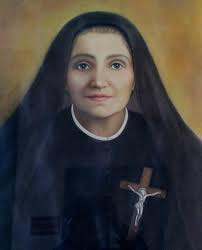A Model for Mothers and Religious Alike

Sunday Beatification for Woman Who Lost Husband, 6 Children
By Carmen Elena Villa
ROME, SEPT. 30, 2010 (Zenit.org).- "If a happy person has existed in life, it is I," Mother Anna Maria Adorni affirmed, despite having suffered the death of her husband and her six children.
Mother Adorni (1805-1893), who at 52 founded the Congregation of Handmaidens of Blessed Mary Immaculate and of the Institute of the Good Shepherd, will be beatified this Sunday in Parma, Italy. Benedict XVI will be represented at the ceremony by Archbishop Angelo Amato, prefect of the Congregation for Saints' Causes.
Xaverian Missionary Father Guglielmo Camera, postulator of her cause of beatification, told ZENIT that the future blessed is a model of a "young Christian, wife, mother and founder."
"It's very original that one person can be a model for several states of life," he said.
Anna Maria Adorni was born and grew up in the town of Fivizziano, in the province of Massa and Carrara in northern Italy. Her father died when she was 15. She wanted to be a Capuchin nun but she gave in to her mother's will and in 1826 married Antonio Domenico Botti, whom she loved very much. Only three months later, her mother died.
"It's enough to love one another very much," said the future blessed about marriage. "All husbands would be good if the women were always attentive to detail and quick," she asserted. She and her husband had six children.
"She thought children were a gift, she really formed them so that they would go to heaven, in the sense of prayer, of faith and the passage from this world to the house of the Father," Father Camera noted.
Harsh test
Her husband died when she was 39, after four months of a severe illness during which she gave him every care. She remained alone with four children (two had already died when very young): Poldino, 16; Alberto, 7; Guido, 4; and Celestina, 3 months.
Anna Maria felt the call to become a consecrated widow, to dedicate herself to works of charity, especially with prisoners: "She was very committed to prisoners, in whom no one was interested," said Father Camera.
"And it wasn't a question of visiting prisons as a way of escape. She was always very committed. She lived this motherhood to those who were not her children," he continued.
Then other moments of pain followed. Her children Guido, Alberto and Celestina died while still very young. Only Poldino was left and he entered a Benedictine monastery and died at 26.
Despite all these sorrows, Anna Maria did not lose hope. Many men of faith admired her attitude and some sought her advice, among them St. John Bosco, Bishop Domenico Maria Villa, and Blessed Andrea Ferrari, archbishop of Milan.
Several women wished to follow her example and thus was born a pious union of women visitors of prisons, under the protection of the Sacred Hearts of Jesus and Mary, an association of women volunteers specialized in prison ministry.
On May 1, 1857, together with eight companions, she started the new Congregation of Handmaidens of Blessed Mary Immaculate of Parma. Two years later, she made with them the private vows of chastity, obedience and poverty.
These women consecrated their religious life to rescuing fallen women, to protecting those in danger, to giving maternal help to the homeless and orphans. "Not only did they go to visit them but they committed themselves to inserting them in society with a job. They received them so as to ensure their future," said Father Camera.
Bishop Andres Miotti of Parma confirmed the statutes of this community on Jan. 28, 1893. Anna Maria died on Feb. 7 that year, just nine days later. "She was clothed in the religious habit practically on her deathbed," commented the postulator of her cause.
Anna Maria's reputation for holiness began to spread rapidly. Some 60 alleged miracles were recorded as due to her intercession. Moreover, many spoke of miracles that the future blessed had wrought in life: "The Lord operated in her life. She had a very beautiful faith because she trusted her confessors, human mediations, sought to understand what the Lord desired, moment after moment, and this faith took her very high," concluded Father Camera. "I think the miracles she worked were due to this faith."

Comments